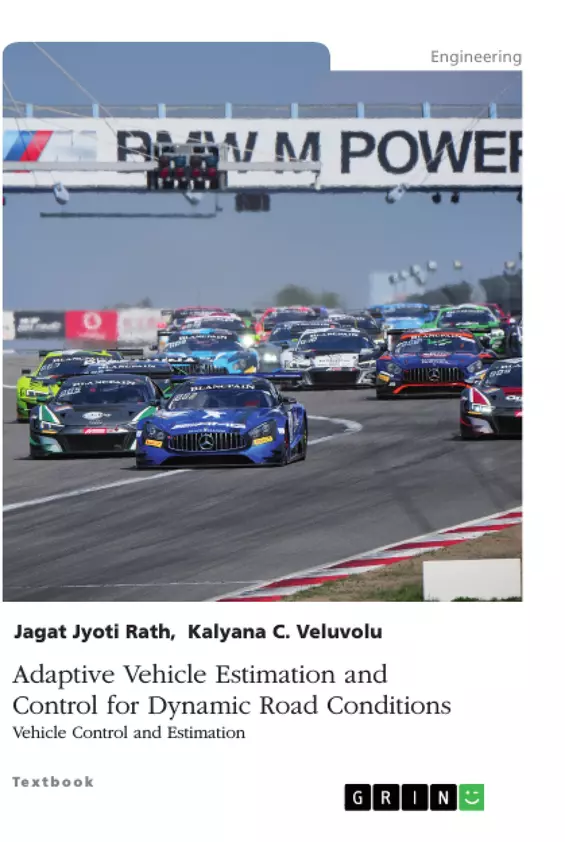Global chassis controller (GCC) design for autonomous vehicles relies on the information of the environmental factors, weather conditions, vehicle dynamics, actuation bandwidth, among others. Typically, various sensors and actuators are employed to provide such information. Challenges such as cost of sensors, actuator complexity and constraints, fail-safe operations, control authority allocation, and adaptability to a wide range of driving scenarios such as acceleration/ deceleration at set speed, double lane change, and driving on a circular path among others persist for design of such GCC architectures.
Specifically for longitudinal-vertical vehicle controllers tuned to achieve safety and comfort objectives, the performance is significantly affected by the precise knowledge of road conditions i.e., tire friction and road elevation in the presence of nonlinearities such as aerodynamic drag, rolling resistance, spring and damper nonlinearities. For the longitudinal vehicle motion, tire-road friction conditions, aerodynamic forces, engine friction, and rolling nonlinearities critically affect the design of safety controllers such as traction control or active cruise control. Similarly, for vertical vehicle motion control using active suspension, the random road roughness and road defects, spring and damper nonlinearities, hydraulic actuator nonlinearities, and multi-objective design criteria, make design of controller a challenging task.
With that motivation, the use cost effective virtual sensors to detect such external inputs and subsequent output feedback control solutions for the longitudinal-vertical autonomous vehicle motion is proposed in this book. The focus lies on adaptability of designed controllers and estimators to road friction conditions such as road conditions such as asphalt, snow, ice and the road elevation based on various rough roads and road defects.
Inhaltsverzeichnis (Table of Contents)
- Introduction
- Vehicle Dynamcis: Estimation and Control
- Motivations
- Contribution of the Thesis.
- Organization of the Thesis.
- Literature Review
- Vehicle Dynamics & Modeling
- Modeling Aspects
- Longitudinal and Vertical Motion.
- Effect of Nonlinearities.
- Effect of Exogenous inputs
- Estimation and Control
- Tire friction estimation
- Longitudinal Motion Control
- Vertical Road Elevation Estimation
- Vertical Motion Control
- Sliding Mode for Automotive Applications.
- Integrated Longitudinal-Vertical Motion: Estimation & Control .
- Longitudinal Motion Estimation
- Overview
- Nonlinear Vehicle Model
- Robust Observer Design
- Unknown Input Reconstruction
- Results. .
- Parameter Selection
- Case: Decelerating vehicle speed
- Discussion
- Summary
- Integrated Longitudinal-Vertical Motion Estimation
- Overview
- Vehicle model
- Robust Observer Design
- Unknown Input Reconstruction
- Results.
- Parameter Selection
- Case I: No Speed Control
- Case II: PI Speed Control
- Discussion.
- Discussion
- Summary
- Output Feedback Vertical Motion Control
- Overview
- Vehicle model
- High Gain Observer
- Robust Sliding Mode Controller.
- Active Control Objectives
- Results and Discussion . .
- Parameter Selection
- Case: Road conditions, uncertainties and sensor noise
- Discussion.
- Summary
Zielsetzung und Themenschwerpunkte (Objectives and Key Themes)
This book focuses on designing cost-effective virtual sensors for detecting external inputs like road friction and elevation, and subsequently implementing output feedback control solutions for the longitudinal-vertical motion of autonomous vehicles. The primary aim is to achieve adaptability of controllers and estimators to various road conditions and driving scenarios.
- Development of robust observers for estimating tire friction and road elevation.
- Design of adaptive controllers for longitudinal and vertical vehicle motion.
- Exploration of sliding mode control techniques for automotive applications.
- Integration of longitudinal and vertical motion estimation and control.
- Evaluation of controller performance under varying road conditions and driving scenarios.
Zusammenfassung der Kapitel (Chapter Summaries)
Chapter 1 introduces the concept of vehicle dynamics estimation and control, highlighting the motivations and contributions of the thesis. Chapter 2 provides a comprehensive literature review covering vehicle dynamics modeling, estimation and control techniques, and sliding mode control in automotive applications. Chapter 3 delves into the estimation of longitudinal motion, introducing a nonlinear vehicle model and a robust observer design for tire friction estimation. The chapter discusses the results and parameter selection process for a case study of decelerating vehicle speed. Chapter 4 extends the discussion to integrated longitudinal-vertical motion estimation, including a vehicle model and robust observer design for reconstructing unknown inputs. The results section explores two case studies, one without speed control and another with PI speed control. Finally, Chapter 5 focuses on output feedback vertical motion control, presenting a vehicle model, a high gain observer, and a robust sliding mode controller for achieving active control objectives. The chapter concludes with a discussion of results and parameter selection for various road conditions and uncertainties.
Schlüsselwörter (Keywords)
Autonomous vehicles, vehicle dynamics, estimation, control, tire friction, road elevation, sliding mode control, robust observer design, longitudinal motion, vertical motion, adaptive controllers.
- Quote paper
- Kalyana Veluvolu (Author), Jagat Jyoti Rath (Author), 2020, Adaptive Vehicle Estimation and Control for Dynamic Road Conditions, Munich, GRIN Verlag, https://www.grin.com/document/953254



